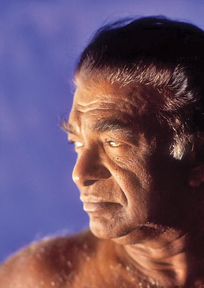Chitrasena legacy lives on
by Husna Inayathullah
The 94th birth anniversary of Maestro Chitrasena
|

Chitrasena, the dancer. |
Chitrasena was a pioneering dancer of Sri Lanka. He is
internationally known for his work in establishing a modern Sri Lankan
tradition of dance and popularising Sri Lankan dance forms worldwide. He
is credited for rescuing our dying art-form by reviving and refining
elements of ancient rituals and presenting them on the stage.
Amaratunga Arachige Maurice Dias alias Chitrasena was born on January
26, 1921 at Waragoda, Kelaniya. His father was the late Seebert Dias,
well-known actor and producer of the 1920s and 1930s.
Chitrasena was encouraged by his father from a young age to learn
dance and theatre. His legacy and vision is sustained by the third
generation of the Chitrasena family and students at the Chitrasena
Kalayathanaya.
In 1950, Chitrasena married his brilliant pupil Vajira. Vajira's most
valuable contribution other than her creations is the transforming of
the masculine Kandyan dance to a very feminine dance form. She mastered
the original style of Kandyan dance from traditional masters.
Femininity
She realised that elements of femininity came to her dance naturally.
With her grace, elegance, expression of emotions in performing she made
an indelible stamp on the Kandyan female dance style. It gave a new
dimension to the Kandyan dance. Vajira entered the stage at the correct
time when Sri Lankan Society was prepared to receive dance as a
sophisticated performance.
The Chitrasena Kalayathanaya was started in 1944 in Colombo. It was
the centre of new forms of arts and culture from the 1940s to the 70s.
It was begun in a rented house gifted by philanthropist Sir E. P. A.
Fernando.
The Kalayatanaya building is situated a few yards away from
Kollupitiya junction and was the oasis of contemporary innovators who
searched for new vistas in the aesthetic field.
Chitrasena and Vajira introduced a new creative dance form based on
indigenous dance to these young artistes. The school started with only a
handful of students who lived and worked in the Studio.
The Kalayathanaya is now known as the Chitrasena-Vajira Dance
Foundation. Since Chitrasena's death in 2005, the Foundation is managed
by his wife, Vajira and daughters Upeka and Anjalika.
A review was written by Deborah Jones on the performance of the
Chitrasena Dance Company at the prestigious 2015 Sydney Festival held
from January 8 to 11. It was published in The Australian on January 12
as a tribute to the maestro.
It was mentioned as "Thaji Dias stars in Chitrasena Dance Company's
Dancing for the Gods." The reviewer Deborah Jones said that if there is
a more immediately captivating dancer than Thaji Dias, I have yet to see
her, or him. Dias is the leading dancer of Sri Lanka's Chitrasena Dance
Company, granddaughter of its founder and was clearly born to carry on
his work. She isn't the only reason to see the company but would be
reason enough.
Sydney Festival
At the Sydney Festival on Thursday evening, Dias dazzled on every
level: her technical command was exhilarating and her artistry
ravishing, and if that were not enough Dias has megawatts of charisma.
Chitrasena Dance Company was founded in the 1940s and has appeared in
Australia twice, although not for 40 years. It's a fair bet that unless
they were from the local Sri Lankan community, the audience members
would have been seeing something entirely new, as was I".
There are similarities with better-known classical sub continental
genres but the Kandyan style at the heart of Chitrasena's work has its
own character. It is an electric, powerful, dramatic form.
Incredibly seductive, too. The gods to whom these dances pay homage
didn't shrink from sensual pleasures.
While there are historical, ritualistic and devotional aspects to the
dance, they have been adapted for the contemporary stage - not least in
giving roles to women that were originally for men only.
This is concert dance, the old forms interpreted and developed by
Chitrasena's artistic director and very fine choreographer, Heshma
Wignaraja, also a granddaughter of the company's founder.
The group is not large - seven dancers; four drummers - and the
production is modest. Nevertheless, it is rich in effect. Dancing for
the gods presents six dances in three sections (Ritual, Rites,
Reflection) connected with aspects of worship and celebration, performed
to intricate, robust, formidably blood-stirring drumming and chanting.
An introduction featuring the Demon God (danced by Akila Palipana)
shows him as a maniacally swirling being, the upper body swinging
ecstatically in an increasingly fast and wide circle.
A sinuous trio for men in honour of the Ganesha, God of Knowledge has
a meditative quality and an intriguing trio for women arrestingly
contrasts vivid poses with rapid sweeps around the stage. In this piece,
Pantneru Matha, the dichotomies of love and war, past and future are
evoked.
Dias took part in this trio and in two solos of greatly different
nature. The second had a contemporary feel despite its traditional
vocabulary and was interior in quality.
The dancer looked within herself. In the first solo, Dias reeled her
audience in effortlessly with divinely articulated wrists, rippling
shoulders, jaunty strides around the stage, the deepest and plushest
plies and her warm, direct gaze. She is an artist of exceptional
individuality.
The late great Guru Chitrasena's contribution comes alive, re-born,
each time his pupils, or his pupils' pupils perform in his grand
tradition. His legacy will live on.
|

